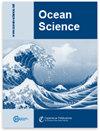南极洲威德尔海南部大陆斜坡上方的局部温度突然升高
IF 3.3
3区 地球科学
Q2 METEOROLOGY & ATMOSPHERIC SCIENCES
引用次数: 1
摘要
摘要在南极洲的大部分地区,环极深水(CDW)显示出变暖的趋势。与此同时,温跃层正在变浅,从而增加了CDW进入浅大陆架的可能性,并最终增加了沿海岸排列的冰架空洞的基底融化。在温深水(WDW)中也观察到类似的趋势,大约是0.05°C,每十年增加3米,这是威德尔海深处发现的稍微冷却的暖深水衍生物。在这里,我们报道了菲奇纳海槽(74°S, 25-40°W)北部大陆斜坡上方的WDW温度最大值的突然局部升高,该地区被认为是南极底水形成(AABW)和WDW流向大菲奇纳-罗纳冰架的潜在变化的热点地区。2021年夏季获得的新的电导率-温度-深度剖面以及最近(2017-2021年)的系泊记录显示,与历史(1973-2018年)测量值相比,暖水核心在斜坡上部(700-2750米深)的温度增加了约0.1°C。气温上升在2019年底相对突然地发生,并伴随着上覆冬季海水前所未有的(观测)清新。从Filchner海槽沿大陆坡下降的AABW来源于密集的冰架水,占夹带WDW的很大一部分(60%)。因此,所观察到的温度升高可以直接影响到深水的特性,使新产生的底水温度升高(升高幅度可达0.06°C),并降低其密度。本文章由计算机程序翻译,如有差异,请以英文原文为准。
Sudden, local temperature increase above the continental slope in the southern Weddell Sea, Antarctica
Abstract. Around most of Antarctica, the Circumpolar Deep Water (CDW) shows a warming trend. At the same time, the thermocline is shoaling, thereby increasing the potential for CDW to enter the shallow continental shelves and ultimately increase basal melt in the ice shelf cavities that line the coast. Similar trends, on the order of 0.05 ∘C and 3 m per decade, have been observed in the Warm Deep Water (WDW), the slightly cooled CDW derivative found at depth in the Weddell Sea.
Here, we report on a sudden, local increase in the temperature maximum of the WDW above the continental slope north of the Filchner Trough (74∘ S, 25–40∘ W), a region identified as a hotspot for both Antarctic Bottom Water formation (AABW) and potential changes in the flow of WDW towards the large Filchner–Ronne Ice Shelf. New conductivity–temperature–depth profiles, obtained in summer 2021, and recent (2017–2021) mooring records show that the temperature of the warm-water core increased by about 0.1 ∘C over the upper part of the slope (700–2750 m depth) compared with historical (1973–2018) measurements. The temperature increase occurred relatively suddenly in late 2019 and was accompanied by an unprecedented (in observations) freshening of the overlying winter water.
The AABW descending down the continental slope from Filchner Trough is sourced by dense ice shelf water and consists to a large degree (60 %) of entrained WDW. The observed temperature increase can hence be expected to imprint directly on deep-water properties, increasing the temperature of newly produced bottom water (by up to 0.06 ∘C) and reducing its density.
求助全文
通过发布文献求助,成功后即可免费获取论文全文。
去求助
来源期刊

Ocean Science
地学-海洋学
CiteScore
5.90
自引率
6.20%
发文量
78
审稿时长
6-12 weeks
期刊介绍:
Ocean Science (OS) is a not-for-profit international open-access scientific journal dedicated to the publication and discussion of research articles, short communications, and review papers on all aspects of ocean science: experimental, theoretical, and laboratory. The primary objective is to publish a very high-quality scientific journal with free Internet-based access for researchers and other interested people throughout the world.
Electronic submission of articles is used to keep publication costs to a minimum. The costs will be covered by a moderate per-page charge paid by the authors. The peer-review process also makes use of the Internet. It includes an 8-week online discussion period with the original submitted manuscript and all comments. If accepted, the final revised paper will be published online.
Ocean Science covers the following fields: ocean physics (i.e. ocean structure, circulation, tides, and internal waves); ocean chemistry; biological oceanography; air–sea interactions; ocean models – physical, chemical, biological, and biochemical; coastal and shelf edge processes; paleooceanography.
 求助内容:
求助内容: 应助结果提醒方式:
应助结果提醒方式:


